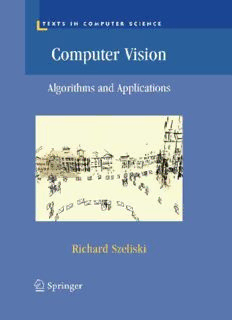Table Of ContentTexts in Computer Science
Editors
DavidGries
FredB.Schneider
Forfurthervolumes:
www.springer.com/series/3191
Richard Szeliski
Computer Vision
Algorithms and Applications
123
Dr. Richard Szeliski
Microsoft Research
One Microsoft Way
98052-6399 Redmond
Washington
USA
[email protected]
SeriesEditors
DavidGries FredB.Schneider
DepartmentofComputerScience DepartmentofComputerScience
UpsonHall UpsonHall
CornellUniversity CornellUniversity
Ithaca,NY14853-7501,USA Ithaca,NY14853-7501,USA
ISSN 1868-0941 e-ISSN 1868-095X
ISBN 978-1-84882-934-3 e-ISBN 978-1-84882-935-0
DOI 10.1007/978-1-84882-935-0
Springer London Dordrecht Heidelberg New York
BritishLibraryCataloguinginPublicationData
AcataloguerecordforthisbookisavailablefromtheBritishLibrary
LibraryofCongressControlNumber:2010936817
© Springer-VerlagLondonLimited2011
Apart from any fair dealing for the purposes of research or private study, or criticism or review, as
permittedundertheCopyright,DesignsandPatentsAct1988,thispublicationmayonlybereproduced,
stored or transmitted, in any form or by any means, with the prior permission in writing of the
publishers,orinthecaseofreprographicreproductioninaccordancewiththetermsoflicensesissuedby
theCopyrightLicensingAgency.Enquiriesconcerningreproductionoutsidethosetermsshouldbesent
tothepublishers.
Theuseofregisterednames,trademarks,etc.,inthispublicationdoesnotimply,evenintheabsenceofa
specificstatement,thatsuchnamesareexemptfromtherelevantlawsandregulationsandthereforefree
forgeneraluse.
Thepublishermakesnorepresentation,expressorimplied,withregardtotheaccuracyoftheinformation
containedinthisbookandcannotacceptanylegalresponsibilityorliabilityforanyerrorsoromissions
thatmaybemade.
Printedonacid-freepaper
SpringerispartofSpringerScience+BusinessMedia(www.springer.com)
Thisbookisdedicatedtomyparents,
ZdzisławandJadwiga,
andmyfamily,
Lyn,Anne,andStephen.
1 Introduction 1
Whatiscomputervision? Abriefhistory
• •
Bookoverview Samplesyllabus Notation
• •
n^ 2 Imageformation 27
Geometricprimitivesandtransformations
•
Photometricimageformation
•
Thedigitalcamera
3 Imageprocessing 87
Pointoperators Linearfiltering
• •
Moreneighborhoodoperators Fouriertransforms
• •
Pyramidsandwavelets Geometrictransformations
• •
Globaloptimization
4 Featuredetectionandmatching 181
Pointsandpatches
•
Edges Lines
•
5 Segmentation 235
Activecontours Splitandmerge
• •
Meanshiftandmodefinding Normalizedcuts
• •
Graphcutsandenergy-basedmethods
6 Feature-basedalignment 273
2Dand3Dfeature-basedalignment
•
Poseestimation
Geometricintrinsiccali•bration
7 Structurefrommotion 303
Triangulation Two-framestructurefrommotion
• •
Factorization Bundleadjustment
• •
Constrainedstructureandmotion
8 Densemotionestimation 335
Translationalalignment Parametricmotion
• •
Spline-basedmotion Opticalflow
• •
Layeredmotion
9 Imagestitching 375
Motionmodels Globalalignment
• •
Compositing
10 Computationalphotography 409
Photometriccalibration Highdynamicrangeimaging
• •
Super-resolutionandblurremoval
•
Imagemattingandcompositing
•
Textureanalysisandsynthesis
11 Stereocorrespondence 467
Epipolargeometry Sparsecorrespondence
• •
Densecorrespondence Localmethods
• •
Globaloptimization Multi-viewstereo
•
12 3Dreconstruction 505
ShapefromX Activerangefinding
• •
Surfacerepresentations Point-basedrepresentations
• •
Volumetricrepresentations Model-basedreconstruction
• •
Recoveringtexturemapsandalbedos
13 Image-basedrendering 543
Viewinterpolation Layereddepthimages
• •
LightfieldsandLumigraphs Environmentmattes
• •
Video-basedrendering
14 Recognition 575
Objectdetection Facerecognition
• •
Instancerecognition Categoryrecognition
• •
Contextandsceneunderstanding
•
Recognitiondatabasesandtestsets
Preface
Theseedsforthisbookwerefirstplantedin2001whenSteveSeitzattheUniversityofWash-
ingtoninvitedmetoco-teachacoursecalled“ComputerVisionforComputerGraphics”. At
thattime,computervisiontechniqueswereincreasinglybeingusedincomputergraphicsto
createimage-basedmodelsofreal-worldobjects,tocreatevisualeffects,andtomergereal-
world imagery using computational photography techniques. Our decision to focus on the
applicationsofcomputervisiontofunproblemssuchasimagestitchingandphoto-based3D
modelingfrompersonalphotosseemedtoresonatewellwithourstudents.
Sincethattime,asimilarsyllabusandproject-orientedcoursestructurehasbeenusedto
teachgeneralcomputervisioncoursesbothattheUniversityofWashingtonandatStanford.
(ThelatterwasacourseIco-taughtwithDavidFleetin2003.) Similarcurriculahavebeen
adoptedatanumberofotheruniversitiesandalsoincorporatedintomorespecializedcourses
oncomputationalphotography.(Forideasonhowtousethisbookinyourowncourse,please
seeTable1.1inSection1.4.)
Thisbookalsoreflectsmy20years’experiencedoingcomputervisionresearchincorpo-
rateresearchlabs,mostlyatDigitalEquipmentCorporation’sCambridgeResearchLaband
atMicrosoftResearch. Inpursuingmywork, Ihavemostlyfocusedonproblemsandsolu-
tiontechniques(algorithms)thathavepracticalreal-worldapplicationsandthatworkwellin
practice. Thus,thisbookhasmoreemphasisonbasictechniquesthatworkunderreal-world
conditionsandlessonmoreesotericmathematicsthathasintrinsicelegancebutlesspractical
applicability.
Thisbookissuitableforteachingasenior-levelundergraduatecourseincomputervision
to students in both computer science and electrical engineering. I prefer students to have
either an image processing or a computer graphics course as a prerequisite so that they can
spendlesstimelearninggeneralbackgroundmathematicsandmoretimestudyingcomputer
visiontechniques. Thebookisalsosuitableforteachinggraduate-levelcoursesincomputer
vision(bydelvingintothemoredemandingapplicationandalgorithmicareas)andasagen-
eralreferencetofundamentaltechniquesandtherecentresearchliterature.Tothisend,Ihave
attemptedwhereverpossibletoatleastcitethenewestresearchineachsub-field,evenifthe
technicaldetailsaretoocomplextocoverinthebookitself.
Inteachingourcourses,wehavefounditusefulforthestudentstoattemptanumberof
smallimplementationprojects,whichoftenbuildononeanother,inordertogetthemusedto
workingwithreal-worldimagesandthechallengesthatthesepresent. Thestudentsarethen
askedtochooseanindividualtopicforeachoftheirsmall-group,finalprojects. (Sometimes
these projects even turn into conference papers!) The exercises at the end of each chapter
contain numerous suggestions for smaller mid-term projects, as well as more open-ended
Description:Humans perceive the three-dimensional structure of the world with apparent ease. However, despite all of the recent advances in computer vision research, the dream of having a computer interpret an image at the same level as a two-year old remains elusive. Why is computer vision such a challenging p

